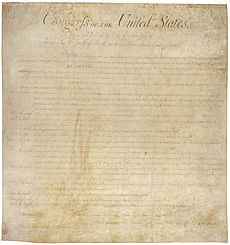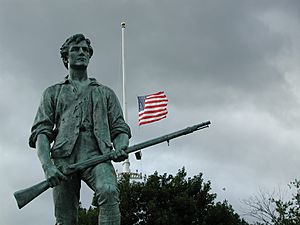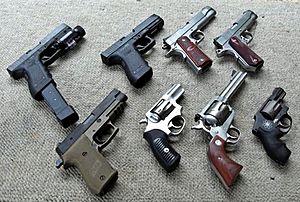Second Amendment to the United States Constitution facts for kids
The Second Amendment to the United States Constitution is a very important part of the United States Bill of Rights. It was created on December 15, 1791. This amendment gives citizens the right to own firearms for lawful reasons. It states: "A well regulated militia, being necessary to the security of a free state, the right of the people to keep and bear arms, shall not be infringed."


Contents
Why the Second Amendment Was Created
When Europeans first came to North America to start colonies, owning firearms was very important. Europeans believed in owning their own land. They got this right from their king through special land grants. This idea was new to Native Americans, who thought land belonged to the whole tribe.
Colonists used firearms to protect their land from Native Americans and other Europeans. They also needed guns for hunting food. In many towns, men had to own firearms to help defend their community.
Most colonists in the 17th century were not soldiers. The British did not keep many soldiers in the colonies. So, colonists soon realized they needed to form their own groups of armed citizens, called militias.
Early Militias and British Actions
Colonies had laws that said every able-bodied man must be ready for militia duty. They also had to bring their own weapons. In 1774 and 1775, the British government tried to take away guns from American colonists. This made the colonists form their own private militias. These militias were not controlled by the British governors.
The Minutemen who fought the British Army at the Battles of Lexington and Concord were an example of an independent militia.
After the American Revolutionary War, the people who wrote the Constitution, called the framers, did not trust large, permanent armies. They trusted militias instead. Americans believed state militias could defend the country.
The Articles of Confederation, which was the first constitution for the new nation, said each state should have a well-armed militia. The Congress could call on these militias to defend the country. However, Congress could only create a permanent army if nine out of thirteen states agreed. This was a weakness that led to the Constitutional Convention of 1787.
In the 18th century, the word "army" often meant soldiers for hire. Americans were afraid that a permanent army could be used to take over the country. People still remembered Oliver Cromwell and his military rule in England.
State Constitutions and Rights
Virginia was one of the first colonies to write its own state constitution. It said: "a well regulated Militia, composed of the body of the people, trained to arms, is the proper, natural, and safe defence of a free State." Other states wrote similar words in their constitutions.
Pennsylvania declared: "the people have a right to bear arms for the defence of themselves and the state." It also said that permanent armies in peacetime were dangerous to freedom. They believed the military should always be controlled by the civil (non-military) government.
In 1781, the Continental Congress approved the Articles of Confederation. This document gave the thirteen original states the power to govern themselves. They had a congress, but it had no money to run things. There was no president and no court system. This system of states working together was a very weak form of central government.
The Constitutional Convention of 1787
The Constitutional Convention met in Philadelphia, Pennsylvania from May 25 to September 17, 1787. The main goal was to improve the Articles of Confederation. But many members, like James Madison and Alexander Hamilton, wanted to create a completely new government.
The delegates chose George Washington to lead the Convention. They eventually agreed on Madison's Virginia Plan. This led to the creation of the United States Constitution and our current form of government.
The Bill of Rights
The discussions about the new Constitution led to two main groups: the Federalists and the Anti-federalists. Federalists wanted a strong central government. Anti-federalists wanted state governments to have more power.
The new Constitution was approved because Federalists promised to add a Bill of Rights. This Bill of Rights would be a list of important freedoms.
Congress first suggested 12 amendments to the states. However, the states only approved ten of them. These first 10 amendments became known as the Bill of Rights. They originally applied to the national government, not to the states. Many states already had their own Bill of Rights. The Bill of Rights was approved and became law in 1791.
Images for kids
-
Ideals that helped to inspire the Second Amendment in part are symbolized by the minutemen.
-
An illustration of Mississippi slave patrol.
See also
 In Spanish: Segunda Enmienda a la Constitución de los Estados Unidos para niños
In Spanish: Segunda Enmienda a la Constitución de los Estados Unidos para niños






